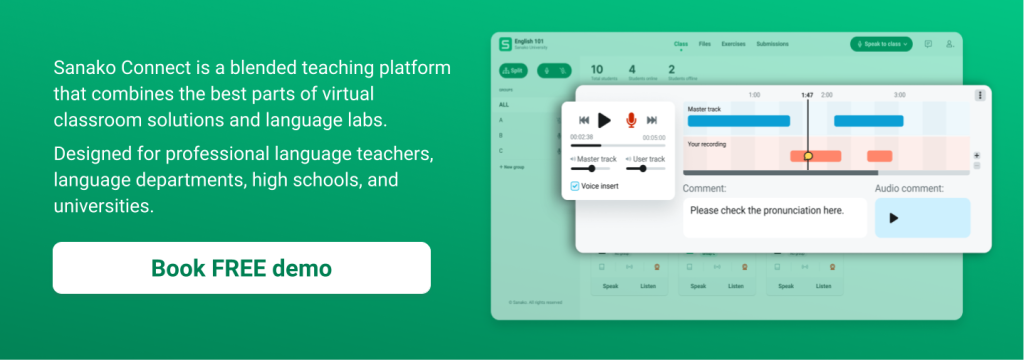Life (and language teaching) is full of debates and decisions. Tea or coffee? Instagram or TikTok? Sweet or savoury? For language educators, deciding whether accuracy is more important than fluency (or the other way around) is one of the big questions that always provokes debate in classrooms and staffrooms.
This blog post, therefore, explores the two key concepts, outlines their importance for language learning, and attempts to conclude which might be most important. We also highlight how educators can develop targeted lesson interventions that help all students to improve both skills. And detail how Sanako solutions can help educators to improve both skillsets.
What is accuracy in language learning?
Accuracy is often what we think about when we are learning a language. The term refers to how correct learners’ use of the language system is, including their use of grammar, pronunciation, and vocabulary. Accuracy, for example, demonstrates a learner’s ability to use the correct verb forms (past tense, present tense, and so on), articles (a, an, the), and prepositions (in, on, from, at).
These are, of course, important skills to learn and the accurate use of language is particularly important in written communication as errors and mistakes tend to stand out more when written down. Such mistakes in all walks of life (particularly in academia or business) can also cause misunderstandings and reflect badly on the writer, suggesting poor attention to detail or even worse, general incompetence.
It takes lots of practice for language learners to become accurate in their target languages and it’s something that’s developed through many small steps. Alongside grammar exercises, definitions, gap fills, and drills, teachers often use controlled practice activities to help students work on their accuracy. These enable repeated practice of the target language, with little variation and minimum amount of free speaking. As the answers are either right or wrong, teachers usually correct mistakes made, either on the spot or after the activity.
What is fluency?
Fluency refers to the ease with which a learner can explain themselves. In other words, how well can they communicate without pauses or hesitations, without needing to search for words or phrases, and without having to think about what they are about to say/write.
When a language learner has good fluency, it means that they can produce and engage with language in a smooth and effortless way. Of course, they might make mistakes, but they’re able to easily communicate their thoughts and ideas in both spoken and written form.
In all settings, language fluency is incredibly important. After all, it’s not much use knowing all of the vocabulary if you cannot use the words to communicate! Building fluency enables learners to explain their views and engage in conversation with peers and/or native speakers. Outside of the classroom, the ability to communicate fluently will help smooth your entry into a foreign culture, making it easier for you to make yourself understood and to fully enjoy your international adventure!
Paul Nation (2003) suggests that the following conditions need to be in place for educators to deliver effective fluency activities for their learners:
- All language items involved are already familiar to students,
- The focus is on communication (not grammatical structure) in real-time, and
- Supports are in place for students to outperform their normal proficiency.
Fluency activities, therefore, tend to focus not so much on how students are communicating but on what they are communicating. Examples of fluency-building language learning activities include peer or group conversations, roleplays, debates, projects, and presentations.
What’s more important: Accuracy or fluency?
All of the research and experts across all commonly taught languages conclude that both accuracy and fluency are vital components for student success and language competency. Yet the practical challenge for educators is all about balance, particularly given that the skills are effectively at the opposite ends of the teaching spectrum. A conversation exercise, for example, is designed to help students practice fluency, teachers shouldn’t be regularly interrupting to correct their mistakes.
So how should teachers prioritize and proceed? From Sanako’s international language teaching experience, the focus has to be on the learner and understanding their motivation for taking the course. Apart from formal academic language courses, the majority of learners are focused on using their language skills outside of the classroom. In that context, the answer to the “Which is more important – accuracy or fluency?” question is clear – it’s fluency! As long as students are accurate enough to be understood, then building fluent, confident and competent communicators are more important.
But how can this be easily delivered in a language classroom? Firstly, it’s worth reiterating that accuracy should always be a major part of any language teaching course. Without an accurate knowledge of their target language, students will never be able to be understood. However, it’s a good rule of thumb that accuracy activities come before fluency activities. This is common sense – there’s no point in building fluency with incorrect forms or incorrect words. Get the basics right and then speed it up.
To that end, be clear about whether activities are designed to build accuracy or fluency and stick to your plan. If fluency is what you’re after, then don’t keep stopping your students if they make mistakes! Wherever possible try and ensure that lessons incorporate opportunities for students to develop both their accuracy and fluency. Creating exercises that replicate real-world situations is a great way to achieve this whatever language you’re delivering.
How can Sanako help language teachers to develop students’ fluency and accuracy?
With customers in 114 countries and our products in use in over 50,000 classrooms globally, Sanako has significant experience in supporting educators to build accuracy and fluency in their students. In fact, our solutions have been specifically developed to support language learners to build their skills in these areas.
Our popular Sanako Connect product, for example, is perfect for building language fluency. Educators can easily divide students into pairs or small groups for live conversation practice and role plays. This takes place in real-time, so each group of students can talk simultaneously without distracting each other. Teachers can listen in or talk with different groups to assist as required. All conversations can be easily downloaded and reviewed for feedback after the event, rather than interrupting live conversations.
Educators can also use Connect to develop activities that improve students’ accuracy. It’s easy to use the platform to create and share tasks addressing specific grammar or vocabulary. These include model imitation, oral assessments, online tests, or fill-in-the-blanks exercises – all of which can be created by educators in minutes.
Check out the video below to find out more how Sanako Connect can help language educators to deliver effective and efficient language lessons.

If you’d like to find out more about how Sanako’s language teaching products could help your educators to improve the accuracy and fluency of their students, please contact us now to arrange your FREE demo!
References used in this article:
Nation, P. (2003). Materials for teaching vocabulary. In B. Tomlinson (Ed.), Developing materials for language teaching (pp. 394–405). London, England: Continuum.

